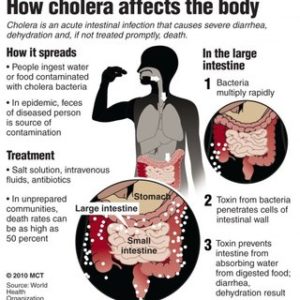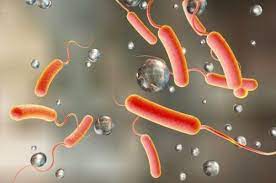Cholera is an acute diarrheal illness caused by infection of the intestine with Vibrio cholerae bacteria. People can get sick when they swallow food or water contaminated with cholera bacteria. The infection is often mild or without symptoms, but can sometimes be severe and life-threatening.
About 1 in 10 people with cholera will experience severe symptoms, which, in the early stages, include:
- profuse watery diarrhea, sometimes described as “rice-water stools”
- vomiting
- thirst
- leg cramps
- restlessness or irritability
Cholera has been nicknamed the “blue death” because a person’s skin may turn bluish-gray from extreme loss of fluids. As dehydration racks the body, blood would begin to thicken in patients’ veins; starved of oxygen, the skin would turns sickly shade of blue. Lack of oxygen for over a several minutes can cause blue of the skin.
Treatment:
Cholera is treated with hydration (given either orally or intravenously), electrolytes, and antibiotics.
The History of Cholera:
The word cholera is from Greek: χολέρα kholera from χολή kholē “bile”. Cholera likely has its origins in the Indian subcontinent as evidenced by its prevalence in the region for centuries.
The disease appears in the European literature as early as 1642, from the Dutch physician Jakob de Bondt’s description it in his De Medicina Indorum. (The “Indorum” of the title refers to the East Indies. He also gave first European descriptions of other diseases.) .
Early outbreaks in the Indian subcontinent are believed to have been the result of poor living conditions as well as the presence of pools of still water, both of which provide ideal conditions for cholera to thrive. The disease first spread by trade routes (land and sea) to Russia in 1817, later to the rest of Europe, and from Europe to North America and the rest of the world, (hence the name “Asiatic cholera”). Seven cholera pandemics have occurred in the past 200 years, with the seventh pandemic originating in Indonesia in 1961.
The first cholera pandemic occurred in the Bengal region of India, near Calcutta starting in 1817 through 1824. The disease dispersed from India to Southeast Asia, the Middle East, Europe, and Eastern Africa. ***The movement of British Army and Navy ships and personnel is believed to have contributed to the range of the pandemic, since the ships carried people with the disease to the shores of the Indian Ocean, from Africa to Indonesia, and north to China and Japan.***
The second pandemic lasted from 1826 to 1837 and particularly affected North America and Europe due to the result of advancements in transportation and global trade, and increased human migration, including soldiers.
The third pandemic erupted in 1846, persisted until 1860, extended to North Africa, and reached South America, for the first time specifically affecting Brazil.
The fourth pandemic lasted from 1863 to 1875 spread from India to Naples and Spain.
The fifth pandemic was from 1881–1896 and started in India and spread to Europe, Asia, and South America.
The sixth pandemic started 1899–1923. These epidemics were less fatal due to a greater understanding of the cholera bacteria. Egypt, the Arabian peninsula, Persia, India, and the Philippines were hit hardest during these epidemics, while other areas, like Germany in 1892 (primarily the city of Hamburg where more than 8.600 people died) and Naples from 1910–1911, also experienced severe outbreaks.
The seventh pandemic originated in 1961 in Indonesia and is marked by the emergence of a new strain, nicknamed El Tor, which still persists (as of 2018) in developing countries.
Cholera became widespread in the 19th century. Now Cholera cases are much less frequent in developed countries where governments have helped to establish water sanitation practices and effective medical treatments.
Cholera morbus is a historical term that was used to refer to gastroenteritis rather than specifically cholera. You’re most likely to get viral gastroenteritis when you eat or drink contaminated food or water. You may also be likely to get gastroenteritis if you share utensils, towels or food with someone who has one of the viruses that cause the condition. Many viruses can cause gastroenteritis, including: Noroviruses.

